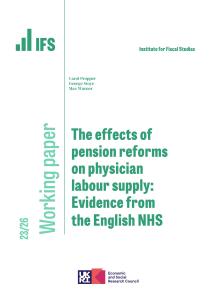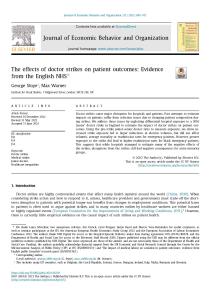Spending on health accounts for a growing share of total public service spending in both Scotland and England.
But increases in health spending in Scotland have been significantly smaller than in England, under both Labour and SNP-led administrations. For example, during the 2000s, official estimates imply that real-terms spending per person increased by 63% in Scotland, compared with 80% in England. And during the 2010s, it increased by 3%, compared with 10% in England. In contrast, the last decade has seen bigger growth in spending on adult social care in Scotland than in England.
As a result, spending on health per person in Scotland went from being 22% higher than in England in 1999–2000, to 10% higher in 2009–10 and just 3% higher in 2019–20, according to official estimates.
The continued convergence in official estimates of health spending levels over the last five years is difficult to square with figures reported in Scottish Government budgets. These suggest increases in funding for its health portfolio that are much bigger than seen for health services in both its own and the UK government’s official spending estimates. In part, this may reflect a growing share of the health portfolio’s budget going to early years and adult social care services. But this is unlikely to explain the entire discrepancy. Given the salience of health spending, the Scottish Government should look to reconcile and explain the differences in these two sets of figures.
In any case, the little evidence that exists does not, overall, suggest that the apparent ‘squeeze’ in relative health spending levels has led to a relative decline in service performance, at least over the last decade.
These are among the findings of a new Scottish Election Briefing Note on Scottish public service spending by IFS researchers, funded by the Scottish Policy Foundation as part of its programme of work to inform public debate in the run-up to the Scottish parliamentary elections.
Other key findings of the report include:
- Total identifiable spending on public services and benefits per person in Scotland was 20% higher than in England in 2019–20. The gap in spending per person on benefits, which is largely based on UK-wide eligibility rules, is much lower – just 6% in 2019–20. The gap for identifiable spending on (largely devolved) public services is much larger, at 27% in 2019–20.
- This gap in identifiable public service spending is up from 21% in 2009–10, largely reflecting the impact of the Barnett formula (and a flaw in it up to 2015–16) during a period of cuts to spending on many services in England. However, the gap had been shrinking during the 2000s, partly as a result of the impact of the Barnett formula during a period of big spending increases, and partly as a result of bigger increases in spending funded by council tax in England: council tax rates increased by 77% in England over the 2000s, compared with 35% in Scotland.
- Spending per pupil aged 3–19 was over £7,000 in Scotland in 2019–20, compared with less than £6,000 in England. Despite this, Scottish secondary pupils do not outperform their English peers on international assessments. This is particularly evident in maths and science, where Scottish pupils’ achievement has fallen over the last 15 years while performance in England has held up to a much greater extent. And, despite substantially higher spending on higher education to avoid tuition fees for undergraduates, published statistics suggest that the share of 18-year-olds entering higher education has grown more slowly in Scotland than in England.
- Overall spending on early years provision is particularly high in Scotland relative to England. This is despite the fact that means-testing of provision for 2-year-olds is more stringent than in England, and the absence of any additional provision for working families. Instead, higher spending may reflect a greater focus on educational development as opposed to childcare, and greater use of local authority managed nurseries, both of which are associated with higher costs. In addition, the Scottish Government has increased hourly funding rates to help nurseries increase the number of hours provided – entitlements are set to double from August this year – something which the UK government did not do when provision was scaled up in England.
- In addition to education, per-person spending on a range of other non-health services is much higher in Scotland than England. This includes adult social care services, on which spending was 43% higher per person than in England in 2019−20 compared with 30% higher in 2009−10 and 27% higher in 1999−2000. Spending is also much higher per person than in England for public order and safety (19% higher in 2019-20), transport (39% higher), environmental protection (54% higher), recreation and culture (76% higher) and housing and community development (96% higher).
- Capital investment spending is also particularly high in Scotland, averaging 30% more per person than the UK average, and a remarkable 51% higher than the average for the English regions outside of London, between 1999–2000 and 2019–20. In contrast, identifiable day-to-day spending on public services and benefits was 14% higher per person than the UK average.
Ben Zaranko, Research Economist at the Institute for Fiscal Studies and an author of the report, said:
“Per-person spending in Scotland is higher than in England for virtually all public services, but devolution allows the Scottish Government to make different choices from the UK government over which services to prioritise.
Over the past two decades, under both Labour and SNP-led administrations, the NHS has been prioritised to a lesser extent than in England. As a result, Scottish health spending per person is now just 3% higher than in England, versus 22% at the start of the devolution. Instead, Scottish governments have placed relatively more priority on other services. Since the SNP has led the government, this includes adult social care, early-years and higher education, and public order and safety.”
Christine Farquharson, Senior Research Economist at IFS and another author of the report, said:
“Scotland spends substantially more than England on education, and that gap has been growing over time. But on a range of indicators, it’s not always clear that this spending delivers better outcomes. 15-year-olds in Scotland have seen their performance on international maths and science tests fall over the past 15 years. Higher education participation has grown more slowly in Scotland than in England, and the gap between disadvantaged students and their better-off peers is larger.
However, the Scottish Government has done more than England did to increase early years funding ahead of bringing in full-time free childcare this summer; still, it will be crucial to evaluate properly the impact that this policy has on children, their families and the childcare sector as a whole.”











